Gigabyte Z68X-UD3H-B3 Review
by Brendan van Varik on July 11, 2011 7:01 AM EST- Posted in
- Gigabyte
- Motherboards
- Sandy Bridge
- Z68
Note: There is a pretty big issue with the shipping (F2) BIOS on the board I received. If any memory settings were chosen (including XMP) rather than left at auto, the board would not engage more than a 1x turbo mode, even in single threaded performance. This issue has been addressed, and Gigabyte suggest that users upgrade to the latest BIOS, available from their website.
The Touch BIOS – no Graphical UEFI
Gigabyte have yet to adopt a full graphical UEFI BIOS. In fact, they merely have a “hybrid” BIOS which adds support for 2.2TB+ hard drives. In order for the 2.2TB+ hard drives to be detected, you have to ‘activate’ them within Windows. You have to run a program to initialize the drives. For the rest, the layout is exactly like a five year old Gigabyte board I have laying around from the LGA775 age.
Unfortunately, this is about as interesting as it gets. It’s a shame that Gigabyte have yet to take on a full UEFI style but it may come in the not too distant future. On the plus side however, Gigabyte have put all of the features in their relative submenus that makes them easy to find. For example, all of the system clocks and overclocking features are located in the MB Intelligent Tweaker (M.I.T.) menu and the settings are under their respective menus in there too. This is relevant for all of the menus within this BIOS.
There are no options to change any of the system fan speeds within the BIOS. However, scrolling down in the PC Health Status part of the BIOS reveals a few options for the CPU fan control. When you select CPU Smart FAN Control and enable it, you can alter the CPU Smart FAN Mode. You can either let it automatically adjust the voltage of the fan or you can manually assign it. If you have a 3 pin fan, you can alter the voltage which will correspond to the speed of the fan or if you have a 4 pin fan, you can set it to PWM mode and the BIOS will take care of it for you. There are four different options which you can choose from whilst using the PWM function. They consist of Normal, Silent, Manual and Disabled.
The TOUCH BIOS from within Windows
Above is the software, which you can use to change absolutely everything in the BIOS from within Windows.
The only obvious issue I found with it is in the M.I.T Status section of this software. It only registers one DIMM no matter which slot it is in but it does register that you are using the correct amount of RAM which is slightly odd.
Overclocking
Just like other manufacturers, Gigabyte have their own software which allows you to overclock your system automatically from within the OS. However, they all vary and some do better than others. We tested out Gigabytes’ offerings before we fiddled and tweaked within the BIOS.
When the EasyTune6 software loads, it loads the Tuner menu by default. There are three different “Quick Boost” options you can choose which consist of a 3.6, 3.8 and 4.1GHz core speed and are labeled 1, 2 and 3 respectively. All three options were tested and proven stable but I will write about the level 3 variable. There are a few things to note here. The voltages set are far too high for the clock speed. A core voltage of 1.4v is set. This particular CPU only requires 1.34v for 4.3GHz. This means there will be excess heat which could be avoided by using less voltage. No Load Line Calibration (LLC) is set during this overclocking procedure, which means the voltage droops to 1.33v when the CPU is highly stressed.
Thankfully, on the RAM side of things it does a little better. The RAM is set to 1866MHz with X.M.P timings and voltages. Our RAM is rated at 2000MHz which isn’t available for selection in the BIOS. There are two options – either 2133MHz or 1866MHz. The safer choice of 1866MHz was chosen to try and eliminate any possible RAM stability issues.
Unfortunately, the CPU core voltage isn’t displayed correctly by CPUZ which means you have to use the EasyTune6 software, which seems to do a better job although I wouldn’t rely on it entirely. The vDroop on this board is something which needs to be addressed. In the BIOS, there are ten levels of LLC, one being the weakest and ten being the strongest. There is no description in the BIOS of how they affect the voltage. When you use no LLC at all, the vDroop on 1.4v can dip right down to 1.33v which is a significant change in voltage. However, when you use level 5, so in the middle of min and max, it will increase the voltage to 1.45v which is far too much again. Gigabyte really do need to sort this out.
Given that the EasyTune6 software only offers a 4.1GHz overclock which uses too much voltage, I was eager to get on and see how well the motherboard overclocks if you set the speeds and voltages on your own accord.
First of all, I tested to see if the CPU would be stable at 4.3GHz with 1.34v just like it is in other motherboard testing. It was semi stable; LLC had to be set to level 3 in order to obtain complete stability. The voltages peaked at 1.36v which isn’t too serious.
After deciding it was stable enough, I pushed on and attempted to find the highest clock speed which could be used to run our benchmarks. The maximum overclock achieved was 102.1x47 which isn’t too shabby at all. The BCLK isn’t as impressive as other motherboards but as you have an unlocked multiplier, you might as well just take advantage of it instead of messing around with the BCLK.
When you push the overclock a touch too far, it sometimes fails to recover from a bad OC without manually simulating the boot cycles. By this, I mean turning the PC on and off by the PSU and letting the board power itself back on. It only takes a few attempts. The motherboard is designed to copy data from the secondary BIOS chip to the first one when the overclock fails in order to recover itself. All this does is restore the BIOS defaults which allows you to either try again or try something different.


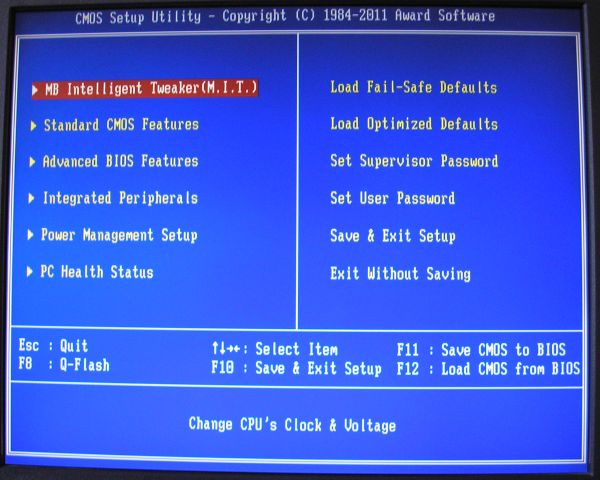
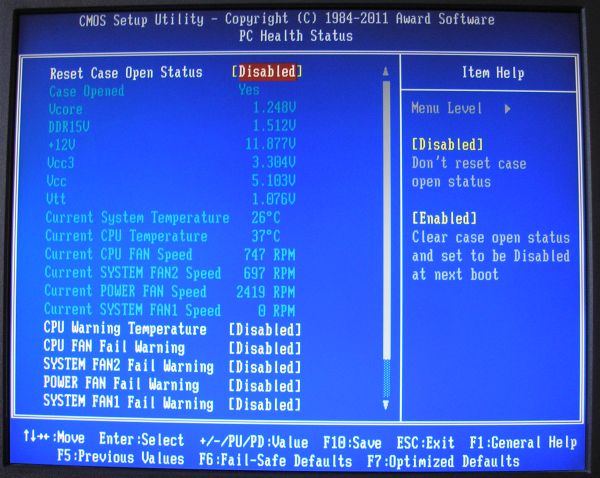






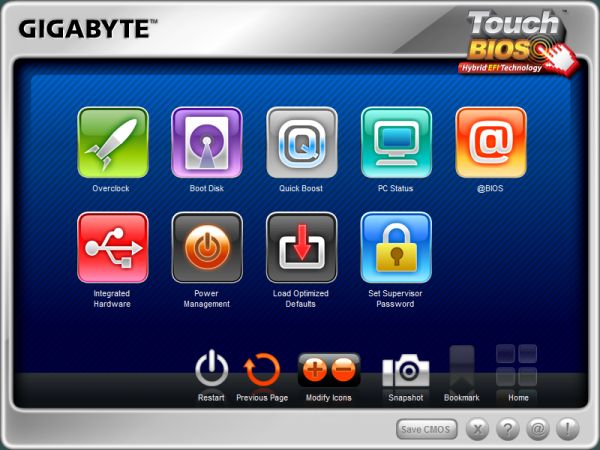
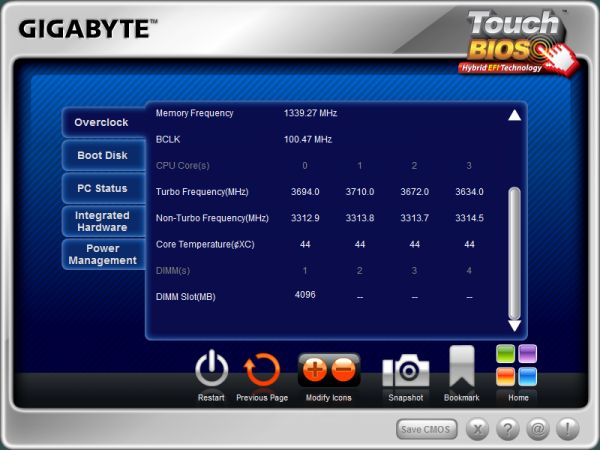
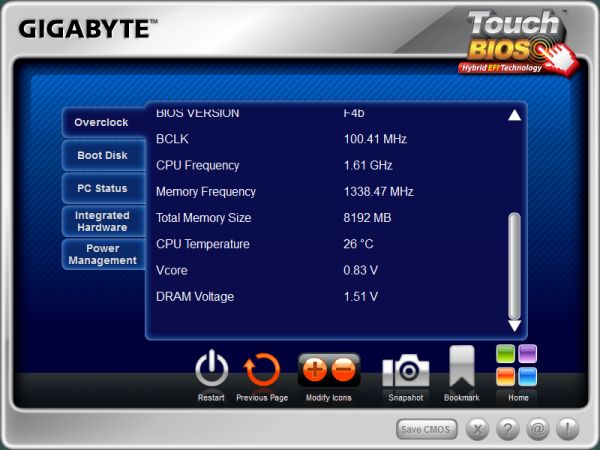














70 Comments
View All Comments
Brutus1234 - Monday, July 11, 2011 - link
I bought one of these from Newegg a couple weeks ago and I'm very happy with it.2600K with a 45x multiplier for 4.5GHz
GSKill RipSaw DDR3 ( 4 Gig ) - system recognizes memory as 2133 with enhanced profile
H70 Corsair Water Cooler
Runs great, Have not touched voltage - it's still all stock.
I've stressed tested it, running some h264 encodes, getting nearly 100% utilization on the CPU for 6hrs and never a hiccup. Temp rarely cracks 50C on the CPU. Very happy with this build
Only thing I have issues with is the Virtu Softare. It recognizes the board but I thought I was getting a licence to use it, and all I can get is a demo mode.
Patrick Wolf - Monday, July 11, 2011 - link
So they implement TouchBIOS but not a GUI? That's just being lazy. FFS, even Biostar has a GUI. Then of course there's the boot loop issue that wasted a lot of my time.http://www.overclock.net/intel-motherboards/103472...
789427 - Monday, July 11, 2011 - link
GUI for bios is *really* a waste of time. Imagine having to connect a keyboard AND a mouse to fix the machine when it breaks...That's like finding a use for a mouse in DR Dos 6.0
Awesome motherboard... lack of fan control shouldn't be too problematic.
Just had a thought though.... if CPUs were delivered in larger packages with the connectors situated off-die, with a vertical arrangement it would be possible to cool both sides of the die at once in a sandwich style cooler.
Twice the surface area to cool means that we'd be in overclocking heaven!
Now we just need Intel to decide to change the sockets again!
86waterpumper - Monday, July 11, 2011 - link
I agree with EnzoFX. If the bios does not cause a boot time slowdown that is pretty well a non issue. However, this day and age lack of fan control in the bios is more than stupid. More and more you are going to see a move to more efficient and power saving features. There is no point in a cpu clocking down and powergating and idling if the fan is going to blast on along like a jet. This is especially true for htpc use which alot are going to use the sandy bridge z68 for. Speaking of that, gigabyte is the one that actually has a z68 board out without a video out on the board at all right? What are they smoking these days :PThe0ne - Monday, July 11, 2011 - link
"Based on the benchmarks and performance figures seen in this review, it shows that you do not have to spend big amounts of money on a motherboard to get on to the Z68 platform. A motherboard that could arguably be aimed at the budget end of the spectrum has performed well "This would fit my needs perfectly. Just wondering why with the comment above it's not a "pick" from you/Anandtech? What's lacking to make it so?
jigglywiggly - Monday, July 11, 2011 - link
U GRAMMAR FARTSSTFU
READ THE ARTICLE FOR THE INFO
fb39ca4 - Monday, July 11, 2011 - link
How is $170 a budget motherboard? This is mid range territory.ratbert1 - Monday, July 11, 2011 - link
Enjoying your baptism by fire? I was going to post about the grammar, but it seems to have all be said.Mr Alpha - Monday, July 11, 2011 - link
Why not run CDM in 0xFF fill mode? Sure, the perfectly compressible data is unrealistic, but it would largely take the flash out of the equation making the benchmark purely about the interface. And when benchmarking a motherboard is it not the limits of the interfaces it provides that really matter?nemitech - Tuesday, July 12, 2011 - link
The test does;t say what version of Lucid was used on the Gigabyte MB vs the Asus one. a new version was released yesterday on the Gigabyte site:http://www.gigabyte.com/products/product-page.aspx...
I can't see any hardware reason that the Gigabyte should be slower than the Asus. Maybe there is a BIOS or Lucid driver update that brings the performance back in par. that is the probelm with reviews, issues are rarely revisited or updated leaving a bad opinion about a product.
This is defiantly a budget MB - I got mine for $105 (!) after $15 rebate, at microcenter this past weekend, with a 2500k for $180. What a bargain. :-)